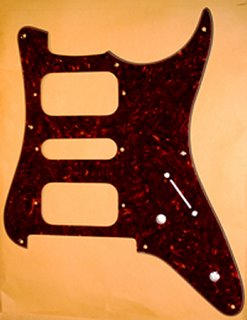
There ain't none! I can't find anyone who has a ready-made pickguard available for this guitar. So that means a custom job and the cost is an unknown right now. I have decided to go through
Pickguards.com, but it depends on their price. I can see the finished Stagemaster in my mind, and what I am seeing is tortoise shell. That's right, tortoise shell.
Fortunately for me, Pickguards.com has the precise color tortoise shell that I can see in my mind. Above is a photo of a sample Strat pickguard taken directly from their web site.
Go to this page and look for the "05 Tortoise Shell" description. It is EXACTLY the shade I want. It will look wicked against that beautiful gloss black.
You may be asking yourself, "the Stagemaster is basically a Strat copy, so why do you need to have a custom pickguard made? Why not just modify the pickup holes on a stock Strat pickguard to accommodate an HSH configuration?"
Simple, the Strat pickguard has 11 screws holding it onto the body, the Stagemaster has 9 and I am doubtful if any of the holes line up. Plus, the stock Strat pickguard will not fit around the Floyd Rose tremolo, I don't think. It sure doesn't look like it would to me.
So what is the procedure to have Pickguards.com make a pickguard? Here you go (straight from the horse's mouth):
Custom Pickguard Tracing Instructions1) Please use only a clean, sharp-pointed writing instrument such as a pencil, pen, or fine tip roller pen. Do NOT use magic markers or anything with a wide tip.
2) Please trace carefully, top side up, on a piece of paper (standard printier/copier paper is recommended. Do NOT use napkins, tracing paper, corrugated cardboard, etc. Also, faxes and photocopies are not acceptable.
3) Please do NOT cut out the tracing once completed.
REMEMBER:
•Your custom guard can only be as good as your tracing, so take your time and follow the above instructions, as custom pickguards are NOT returnable.
•Please remember to indicate the color of the pickguard that you're requesting and provide contact information for yourself so that we may notify you of the cost of your custom guard.
Send tracings to:
WD Music Products, Inc.
Pickguard Dept.
4070 Mayflower Rd.
Fort Myers, FL 33916
So there you have it. As soon as I start taking the Stagemaster apart, which will probably be tomorrow night if time permits, the first priority will be to trace the pickguard and send the tracing to Pickguards.com for an estimate. I will post a photo or two of the finished tracing.
Crispy
 Because Guitar Center is about 35 miles from my house and so far they have had to order everything I've needed anyway, I decided to solve the "pots" issue by buying a set off of eBay. I ended up buying 2 Fender 250 k split shaft pots, which includes capacitors. With shipping they cost slightly more than the 2 Gibsons I was sold at Guitar Center, but who cares. I just want to get on with this.
Because Guitar Center is about 35 miles from my house and so far they have had to order everything I've needed anyway, I decided to solve the "pots" issue by buying a set off of eBay. I ended up buying 2 Fender 250 k split shaft pots, which includes capacitors. With shipping they cost slightly more than the 2 Gibsons I was sold at Guitar Center, but who cares. I just want to get on with this.










